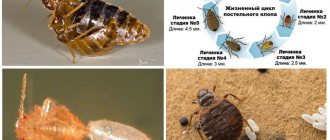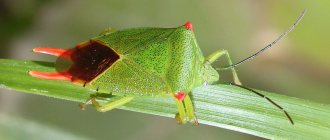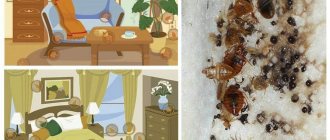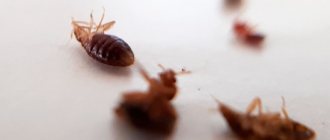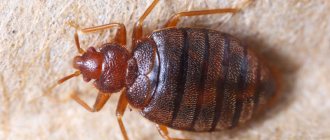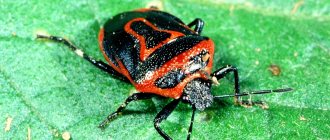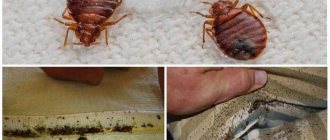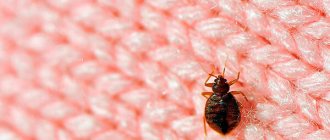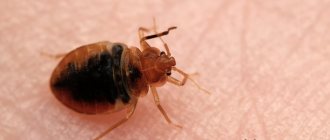Bed bugs photo. How to get rid of bedbugs at home? No way. Just look at real photographs of bed bug infestations in apartments and houses. Without our experienced disinfector, it is very difficult to cope with such situations on your own.
Bed bugs and their photos
NOTE! All photographs of bed bugs and foci of infestation are unique and were taken by our specialists during pest control activities. We hope that photos of bedbugs will help you identify these blood-sucking parasites in your home.
Bed bugs photo. How to get rid of bedbugs at home? No way. Just look at real photographs of bed bug infestations in apartments and houses. Without our experienced disinfector, it is very difficult to cope with such situations on your own. Below are the nests of domestic bugs in the apartment and their photos. If you notice in your apartment something similar to the photo below. There is no doubt that there are bedbugs in the apartment.
How can you tell if there are bedbugs in your house?
Of course, the obvious sign that you have bedbugs in your home is to see them. The photographs of bedbugs presented above clearly demonstrate the situation when bedbugs appear in the house. Carefully inspect your sleeping area; you can find them in the most secluded corners, in the joints of the frame, in the seams of the mattress and folds of fabric. Also, if the bed is light, then you will find the remains of bed bugs, many black dots. This is also a sure sign. Also, when changing bedding, you can find the remains of chitinous membranes after molting and dead insects. Has it happened to many people that when picking berries, such as raspberries, you accidentally crushed a bug? Remember this smell? So bed bugs smell the same, perhaps less intensely. The smell of bedbugs can also indicate their presence in the room. In America there are even services that search for bedbugs by smell using trained dogs. If you find brown spots, smeared blood and crushed insects on the bed. Then rest assured, these are bedbugs.
Let's recognize the enemy by sight
Bed bugs have a number of signs that make them easy to identify. First of all, this is the absence of wings, which makes the pest flatter and more invulnerable. In the process of evolution, bedbugs lost their wings, and it became possible to crawl and hide in the narrowest crevices.
And if you want to crush the little bloodsucker, you will need to arm yourself! Yes Yes exactly! After all, an insect is able to press itself so tightly to the surface that when you press on it with your finger, nothing simply happens to it. The bug needs this ability to squeeze in order to avoid being accidentally crushed by its victim during sleep if the person starts tossing and turning. But this only applies to hungry parasites.
A well-fed insect is not so invulnerable: after drinking blood, the bloodsucker’s body becomes larger and more elastic, and it is much easier to deal with it. It is for this reason that you may see small blood spots on your bed linen in the morning. This is nothing more than a well-fed bug crushed by you!
The size of an adult parasite is approximately 5 -8 mm. Segments are clearly visible on its body, as if the body of the parasite is stretched several times by invisible stripes.
Depending on the saturation of the insect with blood, its color and shape changes. In the photo below you can trace the changes that occur with the parasite as it becomes saturated
The bug grows in length and is no longer so round. The insect also darkens, acquiring a dark brown color.
What do bed bugs look like? Photo
People who encounter bedbugs and their bites do not always immediately understand what is happening in their home. Many believe that the cause of the appearance of red spots on the body is an allergy, and they begin to zealously search for the cause. In the early stages of its development, a bed bug can be confused with a small cockroach, flea or tick. Many city residents, far from the world of insects, may first hear about a bedbug at an appointment with an allergist, where they often come for an explanation of the origin of the red spots - bites - on their bodies.
It is worth being aware of what bed bugs look like because if they appear, you will not be lost in guessing and waste precious time, but will immediately begin to fight them.
Bed bugs (cimex lectularius) are wingless parasitic insects with an oval, flattened body and a size of up to 8 mm. The color of a hungry parasite can be dirty yellow or dark brown. After the linen bug has had its fill of blood, the color changes to scarlet or black, and the body itself becomes more rounded and inactive. Bite marks on a person’s body are clearly visible and resemble tracks - several punctures almost on the same line. Quite often, bites in children can cause an allergic reaction. Read about other dangerous bedbugs in our relevant articles. The larvae externally resemble adults, but are smaller in size and lighter in color, and those that have recently hatched are generally transparent. It is possible to notice them without difficulty only after the parasite has had its fill of blood. Then the stomach with a drop of drunk blood is clearly visible in its transparent body. The parasite eggs laid resemble smaller grains of rice. Elongated shape, white color and length 1 mm. Having glands with a special substance (secret), they have a specific smell when crushed. People call this unpleasant smell the smell of a bug. Difference from other parasites living in the house: The bug, unlike the cockroach, does not have processes in the back in the form of antennae and wings. Its body is more round and smaller in size. To distinguish a bedbug from a tick, you will need to count its legs. The mite is an arachnid parasite and has 8 limbs, but the bedbug has 6. It is more difficult to confuse a bedbug with an ant, but their larvae are very similar. The eggs of the former are wider and shorter. The optimal temperature for good functioning of the parasite is +15 - + 30ºС. These indicators are most often present in a person’s bedroom.
REFERENCE! At low temperatures down to -15ºС, the parasite does not die, but only falls into suspended animation. As soon as the conditions for survival improve, he moves away from this state and safely continues his life activities.
Where do bedbugs come from in an apartment? Routes of entry
Unfortunately, none of us are immune from the appearance of bedbugs in our apartments. There is an opinion that bedbugs live only in dirty, unsanitary rooms; this is far from true; they can inhabit absolutely any apartment. Even if you do a thorough cleaning of your home every day, these “guests” can come to you at any time, or you can bring them into your home yourself.
So where do bed bugs come from? This question is asked by most people who have suffered such a misfortune. There are several common options for the appearance of domestic bedbugs.
- No matter how strange and ridiculous it may sound, it is really possible. Without knowing it, you can bring a bug into your home in a new, just purchased sofa or mattress, in clothes, or in a soft toy. This can happen if the store you shop at is infested with these insects.
— When going on a trip or a business trip, be careful, you can easily “pick up” a bedbug on trains; they can hide behind shelves or in the upholstery of a mattress. In a hotel, especially cheap motels, in a rented apartment, carefully inspect your bags, suitcases, and clothes before returning home.
— House bugs can also come to you from your neighbors. This may be their natural migration, since bedbugs like to travel from apartment to apartment looking for a source of food. Also, if the neighbors left their home for a long time, thereby depriving the bug of food, then the insects will begin to move into the apartment next door. If you smell chemicals, or find out that parasites are being poisoned nearby, then be prepared to meet uninvited “guests”. A bedbug only needs a small gap in the wall, floor, or ceiling to enter your home.
— Your friends, acquaintances, relatives, whose apartment is infested with insects, can also bring a bedbug into your home when they come to visit you. It is possible that, having been in such a house, you will bring yourself a parasite in your belongings or clothes. Bedbugs in the apartment
may remain from the previous owners or tenants of the premises. Hospitals and kindergartens, health camps and sanatoriums, these places can also be infested with bedbugs.
Remember that the bug is a synanthropic arthropod, that is, individuals live in residential premises, populated areas, and on the human body. Bed bugs do not like to remain without food for a long time, so they travel with humans. They are able to cover long distances in a short time. The appearance of a domestic bug in an apartment is fraught with various troubles, such as sleepless nights, nervous shock, bites, rashes, allergic reactions; it has also been established that pathogens of diseases such as the hepatitis B virus, typhoid, Q fever can remain in the insect’s body.
How to determine the presence of bedbugs in a room?
Due to the fact that the activity of these insects manifests itself at night, it is possible to learn about their existence only when their numbers increase significantly. But certain signs can still alert the residents of the house. These include: Bites appear on the body. They can be large or almost invisible (depending on the reaction of the human body). The bedbug especially loves to bite women and children. Their skin is more delicate and easier to bite through. There will be several bites on the body, due to the fact that the parasite, crawling across the body, is looking for a more convenient place to suck blood. Bed linen has red or brown spots.
These spots appear from crushed bedbugs that fell under a person after they had already sucked blood. The body of a hungry bug is flat, which facilitates its movement, but after the parasite has eaten, it can easily burst under the weight of a person. On the bed, in the folds of upholstery on sofas and in blankets, you can find the remains of bedbug skins and eggs that remain after molting. By the way, sofa bugs do not exist as a separate species. They were named so from their habitat in the sofa - these are ordinary bloodsuckers, their photos are shown above.
REFERENCE! You can check whether there really are bedbugs in the room or not thanks to a simple method. It will be enough to turn on the light in the room in the middle of the night and look around the bed. Having discovered pests, you must immediately begin fighting them.
What is important for successful bed bug control? First of all, you need to know the enemy by sight. We bring to your attention detailed materials on whether bedbugs can live in clothes and what they eat, what to put on the skin to prevent them from biting, how to find and destroy their nests in an apartment, what traditional and folk remedies exist, and whether prevention will help avoid the appearance of pests and how to prepare your home for disinfection.
What are bed bugs afraid of?
There are several things you can do to kill or repel bed bugs. What repels insects:
- insecticides (Raptor, Reid, Dichlorvos, Clean House, Fufanon, Agrant, Fumitox);
- high and low temperatures. Sharp temperature fluctuations are a factor influencing the activity of bedbugs. If you lower the temperature in the house to +10°C or increase it to +35°C, bedbugs will begin to look for more comfortable living conditions;
- herbs. The aromas of herbs can repel bed bugs, since they are guided by their sense of smell, for example, they are afraid of the smells of wormwood, tansy, wild rosemary, chamomile, calamus;
- essential oils or perfumes. Another source of pungent and unpleasant aromas for the parasite. A scent that repels bedbugs: essential oils of lavender, rosemary, eucalyptus or cheap cologne;
- traditional methods. Bed bugs are afraid of vinegar, turpentine, denatured alcohol, kerosene, acetone and other compounds with a pungent odor;
- Bedbugs do not like bright light. If you turn on a bright light at night, the parasites will scatter;
- bleach - this powder destroys insects if you pour it directly onto the pest source.
Reproduction and lifespan.
Of the total life period of an insect, a month is spent on the larval phase. During this period, he is not able to reproduce. The rest of the time, females lay eggs, and males actively work as inseminators. One female lays up to 500 eggs of 4-5 pieces during her life cycle. for a day. The larva hatches on the 5th day, and a month later it is already an adult parasite capable of producing offspring. How long does a bed bug live? The average lifespan of a house bug is about a year. If the parasite lives in rooms with low temperatures, its viability lasts up to 14 months. In rooms where the temperature is about 30ºC, the life cycle is reduced to 10 months, but then the number of egg laying increases. But speaking of life expectancy, we should not forget about the parasite’s ability to survive in unfavorable conditions, when the temperature is unsuitable or there is no food source. The parasite feeds once every 5-10 days at night and in one saturation drinks up to 7 mg of blood, which is twice its weight. But if the owners leave the apartment for a long period of time or take the furniture outside, the parasite will safely fall into suspended animation and in this state can remain hungry for up to a year. The chances of survival increase when the hunger strike is accompanied by low air temperatures. In the fight against parasites, many people take their bed mattresses out onto the balcony in 10ºC frost - this will not help. Having thawed from temporary rigor, they pounce on food with even greater appetite.
This is interesting:
To get enough, a bedbug drinks blood twice its body weight.
The pest's mouthparts are two hollow tubes. With the help of one, the insect injects an anesthetic, and the other is intended for sucking blood.
To anesthetize the bite, the bug uses a special enzyme, which subsequently causes itching, and in some people also severe swelling, which takes several days to resolve.
But only adults have the ability to inject an anesthetic. The bug larva does not have this ability, since it does not have a sufficient amount of the secretion that ensures painless puncture of the skin. But in general, due to the small size of the insect and, accordingly, their oral apparatus, the bites of the larvae are insensitive.
The bedbug larvae themselves, or scientifically called Nymphs, are practically no different from adults. The only thing that distinguishes them is their smaller size and lighter color. With regular feeding, the larva quickly grows (on average, this process takes five weeks) and becomes an adult, acquiring the ability to reproduce.
Parasites reproduce by so-called traumatic insemination, when the male pierces the female’s abdomen and injects seminal fluid. After this, the female can lay eggs throughout her life, gradually consuming the male’s seminal fluid.
Just one female is capable of laying 5-12 eggs per day. Below you can see what bed bug eggs look like in bed photos
As a rule, the female lays eggs in those places where she spends most of her time, the so-called nests. They represent a numerous accumulation of adults, larvae, insect eggs, excrement and chitinous shells, which remain after the larvae grow up and molt.
On a note:
Chitinous shells of insects can be found while cleaning under the bed, in corners or on your bed. This indicates that the house is infested with bedbugs and not any other pests.
Appearance of bed bugs
What kind of bugs are they?
The soldier bugs that everyone encountered in forests and parks in the spring are very similar to bed bugs, the only difference is in color and size. But the general appearance of almost all existing bedbugs is quite similar. The common features of all bedbugs are an elongated body, wings with ornaments and a clearly defined head with a proboscis.
Bed bugs belong to the semi-coleopteran order, but in the process of evolution, bed bugs lost their wings due to the transition to a parasitic lifestyle. They are no longer necessary. When hungry, the bug has an almost flat body, which makes it less noticeable and allows it to hide in the narrowest crevices. Bed bugs do not have patterns on their bodies; they are mostly monochromatic and brown in color. The older, the darker. Also, as the bug becomes saturated with blood, it darkens. Young bedbugs can be almost transparent. If you find a nest of bedbugs in your home, you might think that it is young cockroaches. But unfortunately this is not the case. In bedbugs, the abdominal segment is clearly separated from the head. Adult bedbugs have stripes on their bodies.
The main features of the structure of bedbugs:
- no wings
- no pattern on the body
- clear separation between head and body
To forever remember what a bedbug looks like, you just have to see it once.
In a state of hunger, a bedbug is flat and light-colored, while a well-fed bedbug is more elongated and convex. A bug that has drunk blood becomes more vulnerable than a hungry bug. It can be crushed in your sleep and easily caught with your hands, which is almost impossible. In order to kill a hungry bug, it must be crushed with something hard. For example, a coin or a nail. Bed bugs have an elongated feeding apparatus on their head. These are the upper and lower jaws, which, as bed bugs evolved, stretched out and took on their real appearance. In the proboscis of a bug there are 2 channels through one the bug injects saliva, through the other it drinks blood. The bug bites through the skin in the immediate vicinity of the capillaries about 4-5 times and drinks blood at each bite site for about 2 minutes. This is how the trail of bites is formed, the main sign that you were bitten by a bug. After satiation, the bug crawls into a quiet, secluded place and the next time it goes hunting in 2-3 days.
The size of bedbugs ranges from 0.5 cm in a state of hunger and can grow, lengthening almost 2 times after saturation. Young bedbugs are almost transparent or have a yellow tint and are extremely difficult to distinguish.
Habitats and breeding places for bedbugs in an apartment
Once in a new place, house bugs very quickly begin to settle in and reproduce. As a rule, for permanent residence these “neighbors” choose places that are difficult to access and inconspicuous for humans. However, not everything is as scary as it might seem at first glance; a colony of domestic bugs can be detected if you know the main areas of their accumulation.
1. First of all, what you should pay attention to are sleeping places (bed, sofa, sofa, crib, etc.), since domestic bugs mainly feed on human blood, it is much more convenient and easier for them to settle near the source food, that is, with our body. You need to carefully inspect the bed frame, the seams of the mattresses, under the mattress, you may find black spots (excrement) of insects, remains of eggs, or bed bugs themselves. You may also find bloody stains on your bed linen.
2. Look behind paintings, behind carpets, rugs and shelves; you can also find bedbugs or traces of their habitat there, especially if they are located near a person’s place of rest at night.
3. Carefully inspect corners, floor crevices, baseboards, under nightstands, beds and cabinets. Take a broom and dustpan, walk through these places, if you find black dots and insect skins in the garbage, then this is an alarm bell, you have bedbugs.
4. Sockets, another favorite place for house bugs, the heat that electricity produces, as well as the seclusion of the place, makes these parasites comfortable to stay. Under no circumstances try to lure them out of there yourself.
5. Wardrobes, chests of drawers, clothes, books and bookshelves; bedbugs can hide in all these secluded places. Don’t be lazy and inspect the joints of doors, under the window sill, and the folds of curtains.
6. In places where the wallpaper comes away from the walls, bedbugs can also build their “nest”, hiding from the human eye during the daytime. They can be easily detected by simply knocking on the walls.
7. “Our smaller brothers”, they are also susceptible to attack by bedbugs. If you begin to notice that your pet is often itching and suffering from bites, then it is quite possible that this is the work of domestic bugs. Carefully inspect your pet's cage, tray, and sleeping place.
House bugs in an apartment, like any other insects, leave traces characteristic of them, which can be used to detect places of their accumulation and reproduction, as well as to determine the population size. These simple tips will help you in the fight against “bloodsuckers”, and remember, the sooner resistance begins, the easier it will be to clear your home of these unwanted guests.
What do bed bug larvae look like?
What do bed bug eggs look like?
When examined closely, bedbug eggs and larvae look like small grains of rice, half a millimeter in size. The bug usually lays about 3-5 larvae at a time, and therefore they are quite clearly distinguishable. The larvae are found in the same place where bedbugs hide during the day, along with black dots-cysts (excrement) and skins shed after molting.
Everyone has probably seen an anthill in the forest and watched how hard-working ants drag various twigs and their larvae. So, bedbug larvae are very similar to ant larvae. A newborn bug sometimes resembles a transparent aphid; after a couple of meals and molts, as it grows, the bug begins to darken and becomes more like itself. In the transparent body of young bedbugs you can distinguish a black dot; this is the digestive system filled with blood. If a young bug is hungry, it is completely transparent yellow.
Parameters to rely on when choosing funds
All chemicals are formulated for individual use. There is no universal remedy that will eliminate the problem under any conditions and degrees of neglect. List of criteria for choosing a product:
- First of all, safety. Due to the fact that many stores sell substances for household use, high toxicity can lead to negative consequences on the body of residents.
- Efficiency is the very property that is most important when choosing a product. If the drug does not produce results, then its use will be ineffective.
- Deadline for destruction. If you need to get rid of “unwanted guests” in a short time, it is recommended to use aerosols.
- Price. The phrase “quality - price” is not always true. Funds should be selected not by amount, but by quality.
How to properly destroy bed bugs. Video:
How to distinguish bed bugs from other insects
Differences between bedbugs and cockroaches. What do insects look like?
Bedbugs differ from cockroaches just like cats differ from dogs. Bedbugs have a more rounded and flattened body, they are not as fast and mobile as cockroaches and are 2 times smaller in size. Cockroaches have wings, while bedbugs are wingless. Cockroaches mainly live in common areas - kitchen, bath, corridor, toilet; bedbugs prefer to settle in bedrooms and living rooms. The only thing they have in common is that both insects try not to catch the eye of humans and hide during daylight hours.
Differences between bedbugs and lice
Bedbugs do not know how to move normally in fur and hair and prefer open areas of the body, while lice, on the contrary, parasitize precisely in the hairy part of the body. Bedbugs are much larger than lice. Lice bites do not leave trail marks on the body because their bites occur on those parts of the body where it is quite difficult to see them. Body lice living in the folds of clothing and bedding also bite chaotically, their bites are less pronounced than the bites of bedbugs.
Differences between bedbugs and ticks
Many people think when they notice bites that they are ticks. But bedbugs differ morphologically from ticks. Ticks, like all arachnids, have 8 legs, and bedbugs, like all synanthropes, have 6.
Differences between bedbugs and fleas
Fleas bite mainly on open limbs and during the day, a flea bite is painful because... Unlike a bug, it does not anesthetize the bite site. Fleas are extremely mobile, but bedbugs cannot jump.
The main argument in favor of bedbugs is their characteristic bites in tracks of 4-6 points on the human body. No insect bites so specifically.
How to deal with bed bugs
Only special insecticides that cause paralysis of the nervous system of insects can completely destroy parasites. Other remedies will only help repel bedbugs.
Chemicals:
- Aerosol insecticides. With their help, treat areas where pests are believed to have settled, i.e. furniture, mattresses, baseboards, cracks and corners in the house, and in some cases, clothing.
- Insecticidal powders. Effective products that are safe for humans and animals. Carefully scatter them in places where parasites accumulate.
- Smoke bombs. Easy to use and effective.
- "Raptor" (aquafumigator). Produces water vapor with cyphenothrin, a safe insecticide for animals and humans.
- Pest control. If there are too many parasites, they resort to the help of professionals. Exterminators will quickly remove insects using special preparations.
Traditional methods of struggle:
- Herbs and herbal preparations. The smell of plants can repel bed bugs, for example, wormwood, tansy, chamomile and others work great.
- Essential oils. A source of pungent odors, which is suitable for fighting parasites.
- Kerosene, naphthalene, turpentine, ammonia. Use these strong-smelling compounds as carefully as possible, as they can be harmful to health.
Removing pesky bed bugs from your home can be very difficult. These sneaky parasites are able to hide in secluded corners of the apartment and hibernate under unfavorable conditions for their life. When you detect the first signs of an attack by these pests, begin to actively fight them before they infest the apartment and harm your health.
Harmless soldier bug
These insects are easily recognized by the red and black pattern located on the shell. These insects grow up to 1 cm in length, no more. It is believed that the soldier bug is a heat-loving insect and is found in most of what is now Eurasia, where there is a temperate climate. These bugs live in colonies that consist of hundreds of individuals. With the arrival of spring, when the air temperature rises to +10 degrees, colonies of soldier bugs crawl out of their hiding places and bask in the sun. They wait out the winter in a state of suspended animation, hiding in outbuildings, in cracks in street fences, in cracks in dry trees, under bark, etc.
These insects feed on the juices of various plants, piercing the stems and leaves. After an invasion of soldier bugs, young plants stop bearing fruit, wither, and often even die. In the photographs you can see what such insect infestations lead to. After their vital activity, berries, fruits and vegetables become unsuitable for food.
Therefore, the harm from soldier bugs to humans is that they render the harvest of various crops unusable.
Adults mate in a rather interesting way: they are connected by the back parts of their body. After some time, the female lays up to 30 eggs, placing them in plant tissues. After about a couple of weeks, small bright red larvae emerge from the eggs. However, there is no black ornament.
Shield insects
These insects represent a large variety of the bedbug family. Shield insects are found literally everywhere - in garden plots, forests, fields, parks, flower beds, etc. They got their name because of the peculiarities of their body shape, which looks like an irregular pentagon when viewed from above. Almost all representatives of this species of bedbugs emit a specific aroma that can attract males and females, as well as repel natural enemies. Because of this, they are also called “stink bugs.”
Shield bugs, as a rule, do not attack humans. Their diet consists of plant juices, but sometimes they eat dead insects.
On the territory of the European part of the continent, up to 70 species of shield insects are found.
Are bed bugs dangerous?
Finding out where bed bugs come from in an apartment is important in a preventive sense. The answers will help avoid re-infection of premises. Which is very important, because bloodsuckers can not only cause night discomfort with their bites, but also be carriers of serious diseases. Persons with increased sensitization of the body to irritants will suffer from severe allergies after an insect bite. Therefore, in parallel with clarifying the question of why bedbugs appear in an apartment, it is important to understand how to combat them with parasites using effective methods.
Insects easily adapt to difficult living conditions, so with a large population, grandma’s methods will not help. If, during an inspection of the premises, several nesting sites for pests were discovered, it is better to call a professional exterminator. Otherwise, you will have to re-deal with why bedbugs appear in the apartment after control procedures.
Can bedbugs appear from dampness?
What was said in the previous paragraph is completely true for this issue. Bed bugs cannot appear in a house due to dampness or other similar factors. It is necessary to understand that there are conditions that favorably influence the rate of increase in the number of bedbugs in a person’s home. In other words, they do not cause insects to appear in the apartment, but act as an important factor in the rapid growth of the parasite population.
Such conditions include:
- temperature ranging from +25 to +35 degrees;
- normal or slightly increased level of natural humidity in the premises;
- hidden corners in an apartment or house;
- infrequent or poor quality cleaning of rooms and other areas of the home;
- permanent residence in the house or apartment of the residents.
Another factor that has a positive effect on the size of the bedbug population is the lack of a prompt response from homeowners to the fact that parasites have appeared in it. In this case, nothing prevents the latter from reproducing calmly and quickly. As a result, there is a natural expansion of the habitat when insects appear in neighbors’ apartments.
Insect habitat conditions
It is a mistake to think that bedbugs necessarily require unsanitary conditions to live. They feel great both in a rustic barn with animals and in a luxurious apartment with expensive renovations.
If insects appear in an apartment building or in one of the apartments, then soon their invasion is expected in other apartments. Walls and floors for bedbugs are not an insurmountable obstacle. Insects move easily around the house. Residents of neighboring apartments should immediately prepare for problems with bedbugs. The fight ahead will not be easy.
